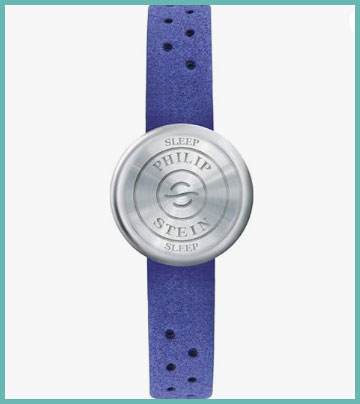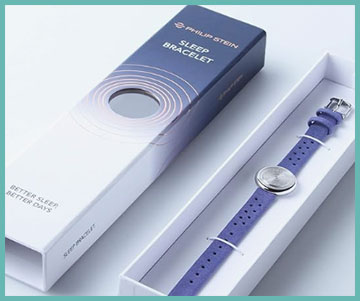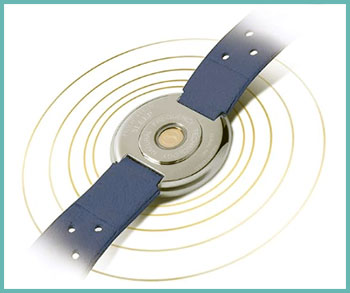If you’re tossing and turning at night, desperate for a solution to your sleep woes, you might have stumbled across the Philip Stein Sleep Bracelet.
It’s marketed as a game-changer, promising deeper sleep and a refreshed morning through its Natural Frequency Technology. Sounds intriguing, right? But after digging into user experiences, scientific claims, and my own trial, I’m skeptical.
The bracelet’s high price and mixed results make it a tough sell. In this article, I’ll share my journey, break down the pros and cons, offer maintenance tips, compare it to other brands, and answer your burning questions.
My Experience With The Philip Stein Sleep Bracelet
I’ve always struggled with sleep. Whether it’s my brain refusing to shut off or waking up at 3 a.m. for no reason, getting a solid night’s rest feels like chasing a unicorn. So when I heard about the Philip Stein Sleep Bracelet, I was curious but cautious.
The idea of a bracelet channeling “natural frequencies” to help me sleep better sounded like something out of a sci-fi novel, but I was willing to give it a shot. After all, who wouldn’t want to wake up feeling like they’ve just had the best nap of their life?

The bracelet arrived in a sleek, luxurious box, which immediately made me feel like I was unboxing something special. It’s lightweight, with a soft, breathable microfiber strap and a stainless steel disc that houses the so-called Natural Frequency Technology.
The instructions were straightforward: wear it 15–30 minutes before bed for 30 consecutive nights to feel the full effects. I adjusted the strap to fit my wrist, which was easy thanks to the multiple holes and sturdy buckle, and slipped it on that first night with high hopes.
For the first week, I didn’t notice much. I followed the routine religiously, putting it on while winding down with a book (no screens, as recommended). My sleep was about the same—some nights I drifted off quickly, others I stared at the ceiling. By week two, I thought I might be sleeping a bit deeper, but it was hard to tell if it was the bracelet or just my body adjusting to a new routine.
I did wake up feeling slightly more refreshed a couple of times, but nothing life-changing. Then came the hiccups. One night, I forgot to wear it, and I slept terribly—tossing, turning, the works. Was it the bracelet’s absence or just a bad night? I couldn’t be sure.
By the end of the 30 days, I was frustrated. The bracelet didn’t deliver the consistent, transformative sleep I’d hoped for. I had some good nights, sure, but nothing I could definitively credit to the bracelet. The placebo effect is real, and I wondered if my slight improvements were just my mind wanting it to work.
Worse, I started noticing discomfort—my wrist felt irritated where the metal disc sat, especially after long nights. When I read reviews mentioning nerve pain or no benefits at all, I started questioning whether this was worth the hefty $395 price tag. My experience left me skeptical, and I’m not alone in feeling let down.
Pros Of The Philip Stein Sleep Bracelet
Let’s give credit where it’s due. The Philip Stein Sleep Bracelet has some strong points, even if it didn’t live up to the hype for me. Here’s what stood out during my trial and from other user feedback.
Stylish and Comfortable Design
The bracelet looks sleek and modern, like a minimalist fitness tracker but with a touch of luxury. The microfiber strap is soft and breathable, with perforated holes that prevent it from feeling sweaty or sticky during the night. I appreciated how lightweight it was—most nights, I barely noticed it on my wrist. The stainless steel buckle and disc add a premium feel, making it look like something you’d want to wear, even if you’re skeptical about its claims. For those who value aesthetics, it’s a nice accessory that doesn’t scream “sleep aid.”
No Batteries or Charging Required
Unlike other sleep tech that needs constant charging or battery replacements, the Philip Stein Sleep Bracelet is low-maintenance in that sense. The Natural Frequency Technology doesn’t rely on electronics, so you don’t have to plug it in or swap out batteries. This was a relief for me—I’m terrible at remembering to charge my devices. You just slip it on and go, which is a big plus for anyone who wants a hassle-free solution.

High-Quality Materials
The craftsmanship is undeniable. The materials feel durable, and the bracelet is designed to withstand nightly wear (though some users reported strap issues, which I’ll get to later). The hypoallergenic strap is a thoughtful touch for those with sensitive skin, and the stainless steel components give it a polished, long-lasting vibe. Philip Stein’s reputation for quality timepieces carries over here, and it shows in the bracelet’s construction.
Potential for Placebo Benefits
I can’t ignore that some users swear by this bracelet. In a 2009 study by NeuroTrials Research, 43% of participants felt more refreshed when wearing it compared to a placebo. While the study was small and funded by Philip Stein, it suggests some people might experience benefits, even if it’s psychological. For me, there were nights when I felt a bit more rested, and I can see how believing in the bracelet’s tech could amplify that effect. If you’re open to trying alternative wellness solutions, this might give you a mental boost.
30-Night Trial Period
Philip Stein offers a 30-night trial, which is a nice safety net. If it doesn’t work for you, you can return it (check their website for details). This takes some of the sting out of the high price, as you’re not locked in if you don’t see results. I wish I’d taken advantage of this, but I kept hoping for a breakthrough that never came. Still, it’s a consumer-friendly feature that shows confidence in the product.
These pros make the bracelet appealing on paper, but they weren’t enough to outweigh the downsides for me. Let’s talk about those next.
Cons Of The Philip Stein Sleep Bracelet
The Philip Stein Sleep Bracelet sounds promising, but it falls short in several areas. After my experience and reading user feedback, here’s why I’m hesitant to recommend it.
Questionable Science Behind Natural Frequency Technology
The bracelet’s big selling point is its Natural Frequency Technology, which claims to channel earth’s natural frequencies to boost melatonin production and improve sleep. Sounds cool, but where’s the evidence? The science is murky at best. A small 2009 study cited by Philip Stein showed some benefits, but it only involved 35 people and was company-funded. Independent, large-scale studies are nonexistent, and experts like Dr. Neil Branda have only vaguely supported the claims without hard data. I’m not convinced this isn’t just a fancy placebo.
Inconsistent Results
My experience wasn’t unique—many users report little to no improvement. On Amazon, some called it ineffective, with one user saying, “I could not tell that it did anything different at all.” Another mentioned it didn’t help their chronic insomnia. I had similar issues: some nights felt slightly better, but others were no different or worse. The inconsistency is frustrating, especially when you’re shelling out nearly $400 for a sleep solution that doesn’t deliver reliably.
High Price Tag
At $395, this bracelet is a luxury purchase, not a casual buy. For context, you could get a high-end fitness tracker or a month’s worth of therapy for that price. I felt the cost was hard to justify, especially when the benefits were so hit-or-miss. If you’re on a budget or skeptical about unproven tech, this price feels like a gamble. Other users echoed this, with one calling it “an expensive placebo.” If it doesn’t work, you’re out a chunk of change, even with the trial period.

Potential Discomfort or Side Effects
While the bracelet is designed for comfort, it wasn’t perfect for me. The metal disc irritated my wrist after prolonged wear, leaving it red and sensitive. Worse, I came across a chilling review claiming the bracelet caused nerve damage that persisted for months. While I didn’t experience anything that severe, the possibility is concerning. For a device meant to promote wellness, any risk of discomfort or harm is a red flag.
Durability Issues
Some users reported the strap breaking after just a couple of weeks, which is unacceptable for a premium product. I didn’t have this issue during my month-long trial, but the strap did feel like it could wear out over time. If you’re spending this much, you expect durability, and these reports make me question the bracelet’s long-term value.
These cons make it hard to justify the investment, especially when there are other options out there. Let’s see how the Philip Stein stacks up against them.
Also Read: My Thoughts On The EYEMOS Dry Eye Mask
Comparison With Other Brands
When it comes to sleep aids, the market is packed with alternatives, from wearables to supplements to lifestyle changes. I compared the Philip Stein Sleep Bracelet to a few popular options to see how it holds up. Spoiler: it’s not my top pick.
- First up, let’s talk about the Oura Ring. This sleek, smart ring tracks your sleep patterns, heart rate, and activity levels with precision. Unlike the Philip Stein, it doesn’t claim to “fix” your sleep with frequencies—it gives you data to understand your habits. I tried an Oura Ring for a month, and the insights helped me tweak my bedtime routine, like cutting caffeine after 2 p.m. It’s pricey at around $300, but the app’s actionable feedback feels more empowering than hoping a bracelet’s tech works. Plus, it’s comfortable and durable, with no reports of nerve issues.
- Next, there’s the Hatch Restore 2, a bedside device that combines a sunrise alarm, sound machine, and guided meditations. At $200, it’s cheaper than the Philip Stein and offers a holistic approach. I borrowed a friend’s Hatch for a week and loved the soothing white noise and morning light that eased me awake. It’s not wearable, so it won’t irritate your wrist, and it’s backed by sleep science, not vague frequency claims. The downside? It’s not portable, so it’s less ideal for travelers.
- For a budget-friendly option, I looked at melatonin supplements. A bottle of 3 mg melatonin gummies costs about $10–$20 for a month’s supply. I’ve used these off and on, and while they help me fall asleep faster, they don’t always guarantee deep sleep. Still, they’re affordable, widely studied, and don’t require wearing anything. The catch is potential grogginess or dependency, but they’re a low-risk starting point compared to the Philip Stein’s cost and uncertainty.
- Finally, there’s the Fitbit Sense 2, another wearable at around $250. Like the Oura, it tracks sleep but also offers stress management tools and guided breathing exercises. I wore a Fitbit for a while and found the sleep stage breakdowns (light, deep, REM) super helpful for pinpointing issues. It’s more practical than the Philip Stein, with no pseudoscience involved, though the battery needs daily charging.
- The Philip Stein’s unique selling point—its frequency technology—sounds cool but lacks the evidence to compete with data-driven devices like Oura or Fitbit. The Hatch offers a more comprehensive sleep environment, and melatonin is a cheaper, simpler fix. If you’re set on a wearable, I’d lean toward the Oura or Fitbit for their transparency and functionality.
Maintenance Tips For The Philip Stein Sleep Bracelet
If you decide to try the Philip Stein Sleep Bracelet despite my reservations, keeping it in good shape is key to maximizing its lifespan. Here’s how to care for it based on my experience and user feedback.
Clean the Strap Regularly
The microfiber strap is soft and breathable, but it can collect sweat, oils, or dirt from nightly wear. I noticed mine started to smell faintly after a couple of weeks. To clean it, use a damp cloth with mild soap and gently wipe the strap. Avoid soaking it, as the bracelet isn’t waterproof. Dry it thoroughly with a soft towel to prevent moisture damage. Do this weekly to keep it fresh and prevent skin irritation.

Inspect the Buckle and Disc
The stainless steel buckle and disc are durable, but they’re not invincible. I checked mine regularly for scratches or loosening, especially since the disc is the “tech” part of the bracelet. If you notice any damage, contact Philip Stein’s customer service. Avoid dropping the bracelet, as the disc could get misaligned or cracked, potentially affecting its supposed functionality. Store it in its original box when not in use to protect it.
Avoid Water Exposure
The bracelet isn’t waterproof, which surprised me given its price. I accidentally wore mine in the shower once, and while it didn’t break, I wouldn’t risk it again. Remove it before bathing, swimming, or washing dishes. If it gets wet, dry it immediately with a soft cloth to prevent corrosion or strap degradation. This is especially important for the microfiber, which could weaken over time if exposed to moisture.
Rotate Wearing Position
To avoid irritation like I experienced, try switching the bracelet between wrists every few nights. This prevents the metal disc from pressing on the same spot repeatedly. If you have sensitive skin, consider wearing it looser or taking breaks if you notice redness. One user’s nerve damage claim freaked me out, so I was extra cautious about fit and comfort. Check your skin regularly for any signs of irritation.
Store Properly When Not in Use
When I wasn’t wearing the bracelet, I kept it in its fancy box to avoid dust or accidental damage. If you’re traveling, use a soft pouch to protect it from scratches or pressure. Avoid tossing it in a drawer with other jewelry, as the strap could get snagged or the disc scratched. Proper storage helps maintain its premium look and feel, which is one of its few strong points.
These tips should help you keep the bracelet in top condition, but they don’t address its core issue: questionable effectiveness. Let’s wrap up with some FAQs to clear up common concerns.
Read More: My Thoughts On Bella & Co Bubble Necklace
Frequently Asked Questions (FAQ)
It depends on who you ask. Some users rave about deeper sleep and feeling refreshed, with a small 2009 study claiming 43% of participants felt better. But the evidence is thin, and many, including me, saw no consistent benefits. Reviews on Amazon and Reddit often call it a placebo or ineffective, especially for chronic insomnia. Without robust, independent studies, it’s hard to say it “really” works. You might feel a psychological boost, but don’t expect miracles.
Most users report no side effects, but some, like me, experienced wrist irritation from the metal disc. A concerning Amazon review mentioned possible nerve damage persisting months after use, though this seems rare. The bracelet’s materials are hypoallergenic, but prolonged pressure or sensitivity could cause discomfort. If you notice redness, pain, or numbness, stop wearing it and consult a doctor. Always monitor your skin during the 30-night trial.
Technically, yes, but it’s designed for nighttime use, 15–30 minutes before bed. I tried wearing it during the day a few times, and it felt fine but didn’t seem to add any benefits. Philip Stein doesn’t claim daytime wear improves sleep, and the disc might irritate your wrist over long periods. If you want a daytime wearable, their wellness bracelets might be a better fit, though I’m skeptical of those too.
Yes, Philip Stein positions itself as a luxury wellness brand, known for high-end watches and bracelets. The Sleep Bracelet’s $395 price, premium materials, and sleek packaging scream luxury, and endorsements from celebrities like Oprah and Madonna add to the vibe. But the high cost and unproven tech make it feel more like a status symbol than a practical investment. If luxury is your thing, the quality is there, but the value is questionable.
Conclusion
After a month of wearing the Philip Stein Sleep Bracelet, I’m not sold. Its stylish design, quality materials, and no-battery convenience are nice, but the shaky science, inconsistent results, and steep price make it hard to recommend. I wanted to believe in its Natural Frequency Technology, but my experience—and many others’—suggests it’s more placebo than panacea. Compared to alternatives like the Oura Ring or Hatch Restore, it lacks the evidence and functionality to compete. If you’re curious, the 30-night trial might be worth a shot, but don’t hold your breath for a sleep revolution. Save your money and explore other options first.
